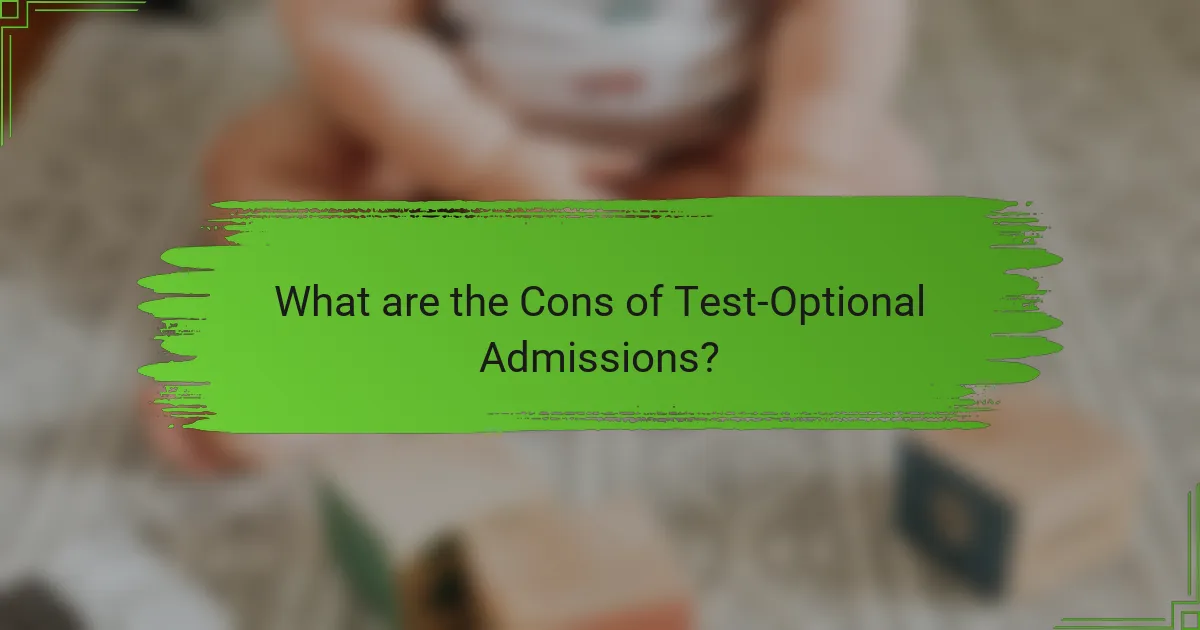
What are Test-Optional Admissions?
Test-Optional Admissions are policies that allow students to apply to colleges without submitting standardized test scores. These policies aim to broaden access to higher education. Many institutions believe that standardized tests do not fully reflect a student’s potential. Test-Optional Admissions can reduce stress for applicants. They may also encourage a more holistic review of student applications. As of recent years, over 1,700 colleges and universities have adopted this approach. This trend has gained traction, especially during the COVID-19 pandemic. The goal is to create a more equitable admissions process.
How do Test-Optional Admissions differ from traditional admissions?
Test-Optional Admissions allow applicants to choose whether to submit standardized test scores. Traditional admissions typically require standardized test scores as part of the application process. Test-Optional policies aim to reduce barriers for students. They focus on holistic review processes, emphasizing grades, essays, and recommendations. Research indicates that test-optional policies can increase diversity among applicants. For example, a 2020 study by the National Center for Fair and Open Testing found that schools adopting these policies saw a rise in applications from underrepresented groups. In contrast, traditional admissions may disadvantage students from lower socioeconomic backgrounds who may not perform well on standardized tests.
What standardized tests are typically excluded in Test-Optional Admissions?
Standardized tests typically excluded in Test-Optional Admissions include the SAT and ACT. These tests are not required for applicants to demonstrate their academic capabilities. Many institutions adopt this policy to promote a more holistic review process. Research suggests that such policies can reduce stress for students. Additionally, it allows for a broader evaluation of a candidate’s potential. Schools embracing this trend often focus on high school GPA and other factors. This shift reflects a growing belief in diverse assessment methods.
Why have colleges adopted Test-Optional policies?
Colleges have adopted Test-Optional policies to promote equity in admissions. These policies aim to reduce barriers for students from diverse backgrounds. Standardized tests often reflect socioeconomic status rather than academic potential. Research shows that high school GPA is a better predictor of college success. As a result, many institutions prioritize holistic review processes. This approach considers various factors beyond test scores. It allows for a more comprehensive evaluation of applicants. In recent years, over 1,800 colleges have implemented these policies.
What are the key features of Test-Optional Admissions?
Test-Optional Admissions allow students to apply without submitting standardized test scores. This policy emphasizes a holistic review of applications. It considers factors like GPA, coursework, and extracurricular activities. Many institutions aim to reduce barriers for diverse applicants. It encourages students to showcase their strengths beyond test scores. Research indicates that test-optional policies can increase application rates. Schools adopting this trend include the University of Chicago and Bowdoin College. These features promote equity in the admissions process.
How do Test-Optional Admissions impact the application process?
Test-Optional Admissions significantly alter the application process by allowing students to choose whether to submit standardized test scores. This policy can reduce stress for students who may not perform well on tests. It also encourages a more holistic review of applicants, focusing on other aspects like grades and extracurricular activities. Studies show that schools adopting this approach can see increased diversity among applicants. For instance, a report from the National Center for Fair & Open Testing indicated that schools with test-optional policies often attract more low-income and minority students. Ultimately, this shift can lead to a broader range of student experiences and backgrounds being represented in higher education.
What criteria do colleges use to evaluate applicants in a Test-Optional framework?
Colleges use various criteria to evaluate applicants in a Test-Optional framework. These criteria typically include high school GPA, coursework rigor, letters of recommendation, personal statements, and extracurricular activities.
High school GPA is often considered the most significant indicator of academic potential. Rigor of coursework reflects the applicant’s willingness to challenge themselves. Letters of recommendation provide insights into the applicant’s character and contributions in a school setting. Personal statements allow applicants to express their motivations and goals. Extracurricular activities demonstrate engagement and leadership outside of academics.
Research shows that many institutions prioritize these factors over standardized test scores in a Test-Optional policy. For instance, a study by the National Center for Fair & Open Testing indicates that colleges have increasingly recognized the limitations of standardized tests in predicting student success.

What are the Pros of Test-Optional Admissions?
Test-optional admissions provide several advantages for students and institutions. They promote a more holistic review process. This allows colleges to consider a student’s overall profile, including extracurricular activities and personal essays. Research shows that students often perform better when not pressured by standardized tests. A study by the National Center for Fair & Open Testing found that test-optional policies can increase diversity. Schools adopting these policies often see higher application rates. Test-optional admissions can reduce stress for students. This approach aligns with a growing recognition of the limitations of standardized testing.
How can Test-Optional Admissions benefit students?
Test-Optional Admissions can benefit students by reducing stress related to standardized testing. Students may focus more on their overall academic performance and extracurricular activities. This approach allows for a more holistic review of a student’s capabilities. It can also increase access to higher education for those who may not perform well on tests. Research indicates that test-optional policies can lead to increased diversity in student admissions. For example, a study by the National Center for Fair & Open Testing found that schools adopting test-optional policies saw an increase in applications from underrepresented groups. Thus, Test-Optional Admissions create opportunities for a broader range of applicants.
What opportunities do Test-Optional policies create for diverse applicants?
Test-Optional policies create increased access for diverse applicants. These policies allow students to apply without submitting standardized test scores. This reduces barriers for those from underrepresented backgrounds. Many diverse applicants may face challenges in standardized testing environments. Test-Optional admissions consider other aspects of a student’s application. Factors such as GPA, extracurricular activities, and personal statements gain more importance. Research shows that diverse students often perform better in holistic admissions processes. This approach can lead to a more equitable representation in higher education.
How do Test-Optional Admissions reduce stress for students?
Test-Optional Admissions reduce stress for students by eliminating the pressure to perform well on standardized tests. This policy allows students to focus on their overall academic performance and extracurricular activities. Many students experience anxiety related to test-taking. By removing this requirement, institutions create a more inclusive environment. Research indicates that students feel more empowered to apply without the fear of low test scores affecting their chances. A study by the National Center for Fair & Open Testing found that test-optional policies can lead to increased application rates among diverse student populations. This shift promotes a holistic evaluation of students, recognizing varied strengths beyond test scores.
What advantages do colleges gain from Test-Optional Admissions?
Colleges gain several advantages from test-optional admissions. They can attract a more diverse applicant pool. This inclusivity can enhance the institution’s reputation. Test-optional policies often lead to increased application numbers. For instance, the University of Chicago saw a 25% increase in applications after adopting this policy.
Moreover, colleges can focus on holistic admissions processes. This approach evaluates students based on various attributes, not just standardized test scores. It allows for a more comprehensive understanding of a student’s potential. Additionally, test-optional admissions can reduce the stress on students. This reduction can lead to improved mental health and well-being among applicants.
Overall, these advantages contribute to a more equitable admissions process. They align with the growing trend of prioritizing diversity and inclusion in higher education.
How does Test-Optional Admissions influence enrollment rates?
Test-Optional Admissions positively influence enrollment rates by increasing the number of applicants. Schools adopting this policy often see a broader applicant pool. This inclusivity can lead to higher acceptance rates. Research shows that institutions with test-optional policies experienced a 5-10% increase in applications. For example, a study by the National Association for College Admission Counseling found that test-optional schools had a 12% growth in enrollment. The absence of standardized test requirements reduces barriers for underrepresented students. This shift can enhance diversity on campuses, which is appealing to prospective students. Overall, test-optional admissions contribute to a more equitable admissions process.
What role does Test-Optional Admissions play in enhancing campus diversity?
Test-Optional Admissions enhance campus diversity by allowing a broader range of applicants to be considered. This policy removes standardized test scores as a requirement, which can disadvantage underrepresented groups. Research shows that students from diverse backgrounds often face barriers in standardized testing. By adopting a test-optional approach, institutions can focus on holistic evaluations. This includes factors like personal essays, extracurricular activities, and recommendations. As a result, colleges attract a more diverse applicant pool. For example, the University of California reported increased applications from low-income students after implementing test-optional policies. This trend promotes equity in admissions and fosters a richer campus environment.

What are the Cons of Test-Optional Admissions?
Test-optional admissions can lead to a lack of standardization in evaluating applicants. Without standardized test scores, colleges may rely more heavily on subjective factors. This can introduce bias in the admissions process. Some students may feel disadvantaged if their high school grades are not as strong. Test-optional policies may also lead to increased competition among applicants. Schools may receive more applications, making it harder to stand out. Additionally, some research indicates that test-optional policies may not significantly increase diversity. A study by the National Center for Fair & Open Testing shows that test-optional schools do not always enroll more underrepresented students.
What challenges do students face with Test-Optional Admissions?
Students face several challenges with test-optional admissions. One challenge is the uncertainty regarding how colleges evaluate applications without standardized test scores. This can lead to anxiety about whether other application components will be sufficient. Additionally, students may feel pressure to enhance other aspects of their applications, such as essays and extracurricular activities. This can increase the workload and stress levels. Another challenge is the potential for bias in admissions decisions. Some students might worry that their applications will be judged more harshly without test scores. Furthermore, the lack of standardized benchmarks can make it difficult for students to assess their competitiveness. Lastly, students from underrepresented backgrounds may face additional challenges in accessing resources to strengthen their applications.
How might Test-Optional policies affect students’ perceptions of their academic abilities?
Test-Optional policies may positively influence students’ perceptions of their academic abilities. By removing standardized test requirements, students may feel less pressure and anxiety regarding their performance. This can lead to a more confident self-assessment of their academic skills. Research indicates that when students are not required to submit test scores, they often focus on other strengths, such as coursework and extracurricular activities. A study by the National Center for Fair & Open Testing found that students admitted under test-optional policies reported higher self-esteem and greater confidence in their academic capabilities. Consequently, these policies can help foster a more holistic view of student potential, emphasizing diverse talents beyond test scores.
What risks do students take by not submitting standardized test scores?
Students risk being at a disadvantage in the admissions process by not submitting standardized test scores. Many colleges use these scores as a metric for academic readiness. Without scores, students may lack a quantifiable measure to showcase their abilities. This can lead to a perception of lower competitiveness compared to peers who submit scores. Some institutions may also prioritize applicants who provide test scores over those who do not. Additionally, not submitting scores may limit scholarship opportunities, as some merit-based scholarships require standardized test results. In a survey by the National Association for College Admission Counseling, 45% of colleges indicated that standardized test scores are a significant factor in admissions decisions. Thus, students opting out of submitting scores may face increased challenges in gaining admission to their desired schools.
What drawbacks do colleges experience with Test-Optional Admissions?
Colleges experience several drawbacks with test-optional admissions. One significant issue is the potential decrease in application quality. Without standardized test scores, colleges may struggle to assess academic readiness accurately. This can lead to a less competitive applicant pool. Another drawback is the increased complexity in the admissions process. Admissions committees must rely more on subjective measures, such as essays and recommendations. This can introduce bias and inconsistency in evaluations. Additionally, colleges may face challenges in maintaining academic standards. Some institutions report a rise in enrollment of students who may not be prepared for college-level work. This can affect retention rates and overall institutional performance. Lastly, test-optional policies can create confusion among prospective students. Many may not understand the implications of choosing not to submit scores, leading to uncertainty in their application strategy.
How can Test-Optional policies complicate the admissions process for colleges?
Test-Optional policies can complicate the admissions process for colleges by creating ambiguity in applicant evaluation. Colleges must decide how to assess candidates without standardized test scores. This can lead to inconsistencies in admissions criteria. Some students may feel pressured to submit other materials to compensate for the lack of test scores. Furthermore, colleges may face challenges in comparing applicants fairly. This is especially true when applicants have differing backgrounds and resources. A study by the National Association for College Admission Counseling found that test-optional policies can lead to a more diverse applicant pool, but also complicate the decision-making process for admissions committees. Ultimately, the lack of a common metric can create uncertainty in selecting candidates.
What concerns exist regarding the fairness of Test-Optional evaluations?
Concerns regarding the fairness of test-optional evaluations include potential bias in admissions decisions. Critics argue that these policies may favor students from privileged backgrounds who have access to better resources. Test-optional evaluations can lead to inconsistencies in how applications are reviewed. Some institutions may still implicitly favor standardized test scores, disadvantaging those who choose not to submit them. Research indicates that students from marginalized communities may be less likely to apply if tests are optional, impacting their representation. Furthermore, the lack of standardized metrics can complicate comparisons between applicants, leading to subjective decision-making.

Which Schools are Embracing Test-Optional Admissions?
Many universities are embracing test-optional admissions policies. Notable examples include Harvard University, the University of Chicago, and the University of California system. These institutions have made standardized test scores, such as the SAT and ACT, optional for applicants. This trend reflects a growing recognition of diverse student experiences and abilities. Research shows that test-optional policies can lead to increased enrollment of underrepresented students. The National Center for Fair & Open Testing reports that over 1,800 colleges and universities have adopted this approach. This shift aims to create a more equitable admissions process.
What notable colleges have adopted Test-Optional policies?
Notable colleges that have adopted Test-Optional policies include Harvard University, University of Chicago, and Stanford University. Harvard implemented this policy in 2007 to promote a more holistic admissions process. The University of Chicago became one of the first top-tier institutions to adopt it in 2018. Stanford also adopted a Test-Optional policy to enhance diversity and accessibility in their admissions. Other institutions include the University of California system and Bowdoin College, both of which have emphasized a commitment to equity in admissions practices.
How have specific institutions implemented Test-Optional Admissions?
Specific institutions have implemented test-optional admissions by allowing applicants to choose whether to submit standardized test scores. For example, the University of Chicago adopted this policy in 2018, emphasizing a holistic review process. Similarly, Harvard University announced a temporary test-optional policy for the 2021 admissions cycle due to the pandemic. Other institutions, like the University of California system, have permanently eliminated standardized testing requirements. Research indicates that these changes aim to increase diversity and accessibility in admissions. A study by the National Center for Fair and Open Testing found that test-optional policies can lead to higher enrollment rates among underrepresented groups.
What trends can be observed in the adoption of Test-Optional policies across the country?
The adoption of Test-Optional policies is increasing across the United States. Many colleges and universities are shifting towards these policies to promote inclusivity. This trend gained momentum during the COVID-19 pandemic when standardized testing was disrupted. Research shows that over 1,800 institutions have adopted Test-Optional policies as of 2021. The trend reflects a growing recognition of the limitations of standardized tests in predicting student success. Institutions are also aiming to diversify their applicant pools. Additionally, the trend is supported by studies indicating that Test-Optional policies can lead to increased enrollment from underrepresented groups. Overall, the movement towards Test-Optional admissions is reshaping the landscape of college admissions nationwide.
What resources are available for students considering Test-Optional Admissions?
Students considering test-optional admissions have various resources available. College websites often provide detailed information about their admissions policies. Many institutions offer virtual information sessions to clarify their test-optional stance. Admission counselors are accessible for personalized guidance through emails or phone calls. Online forums and social media groups are valuable for peer support and shared experiences. Books on college admissions often include sections on test-optional strategies. Additionally, educational consultants can provide tailored advice on navigating the application process. Resources like the National Association for College Admission Counseling offer insights on trends in admissions policies.
How can students effectively prepare their applications without standardized test scores?
Students can effectively prepare their applications without standardized test scores by focusing on their strengths in other areas. They should emphasize their high school GPA, which is a strong indicator of academic performance. In addition, students can showcase their extracurricular activities to demonstrate leadership and commitment. Crafting a compelling personal statement can highlight unique experiences and personal growth. Obtaining strong letters of recommendation from teachers can provide insight into their character and abilities. Engaging in community service or internships can further enhance their application by showing initiative and real-world experience. These elements collectively create a well-rounded application that reflects the student’s potential beyond test scores.
What strategies can students use to highlight their strengths in a Test-Optional application?
Students can highlight their strengths in a Test-Optional application by focusing on their academic achievements. They should showcase high grades and rigorous coursework in their transcripts. Including strong letters of recommendation is also vital. These letters should come from teachers who can speak to the student’s abilities and character.
Additionally, students can emphasize extracurricular activities that demonstrate leadership and commitment. Participation in clubs, sports, or community service can illustrate well-roundedness. Crafting a compelling personal statement is crucial as well. This statement should reflect personal growth, challenges overcome, and future aspirations.
Finally, students should present any relevant work experience or internships. These experiences can provide practical skills and insights that enhance their application. By utilizing these strategies, students can effectively communicate their strengths in a Test-Optional context.
Test-Optional Admissions are policies allowing students to apply to colleges without submitting standardized test scores, aiming to enhance access to higher education and promote a holistic review of applications. This article covers the differences between Test-Optional and traditional admissions, the criteria used for evaluation, and the pros and cons of adopting such policies. It highlights the impact on student diversity, application processes, and the experiences of both students and colleges. Additionally, it identifies notable institutions embracing Test-Optional Admissions and provides resources for students navigating this evolving landscape.




